
Bio-ship Paladin, known in Japan as Space Battleship Gomora, is a 1990 horizontally scrolling shoot 'em up arcade game released by UPL and distributed by Sammy Corporation for North American manufacture. It was later ported to the Sega Mega Drive. While the game is essentially a standard horizontally scrolling shoot 'em up, it has an innovation that makes it unique in the genre. The player flies a spaceship which has the standard forward guns to be found in all horizontal scrollers, but it also possesses a weapon that can be manually targeted with a crosshair, in the same manner as in the game Missile Command. This allows the player to fire in any direction with pinpoint accuracy, and adds an extra level of strategy to the game. The game saw an almost arcade perfect port on the Mega Drive, albeit with a few changes that actually enhanced the look of the game such as added parallax scrolling backgrounds in the second level. It would eventually see a worldwide re-release as part of the Arcade Archives series for Nintendo Switch and PlayStation 4 on August 5, 2021.
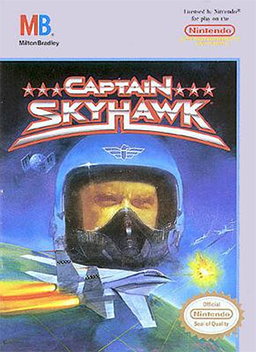
Captain Skyhawk is a scrolling shooter video game developed by Rare and published by Milton Bradley Company. The game was released in North America in June 1990 and in Europe the next year for the NES. It was also released for the PlayChoice-10 arcade machine.
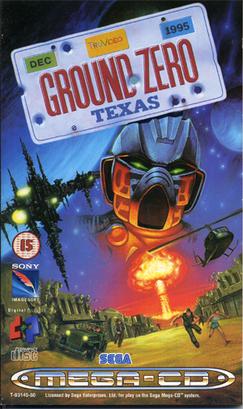
Ground Zero: Texas is a full motion video game, released for the Sega CD in November 1993. The game relies heavily on video footage, with which the player interacts. It contains 110 minutes of interactive footage from four different cameras. It was directed by Dwight H. Little, who is also known for the films Marked for Death and Halloween 4: The Return of Michael Myers.
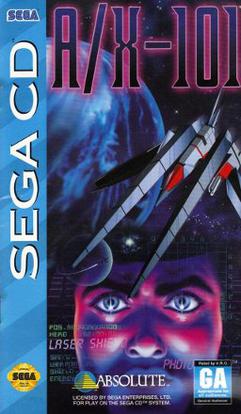
A/X-101 (エーエックス101) is a 1994 rail shooter/FMV video game for the Sega Mega-CD.
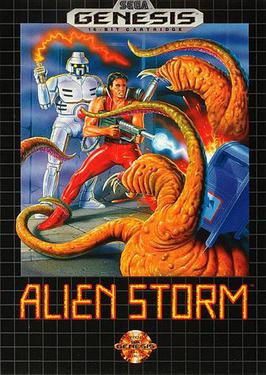
Alien Storm (エイリアンストーム) is a beat 'em up shooter released as an arcade video game by Sega in 1990. It was ported to the Genesis/Mega Drive and Master System. The Mega Drive version was re-released on Wii's Virtual Console in 2007 and was also included on Sonic's Ultimate Genesis Collection for Xbox 360 and PlayStation 3. The game was also re-released on the Nintendo Switch Online + Expansion Pack in 2022.

Alien Soldier is a side-scrolling run and gun video game developed by Treasure and published by Sega for the Mega Drive. Retail copies were released in Japan and PAL territories while in North America it was only available exclusively via the Sega Channel cable service. The story follows a powerful being named Epsilon-Eagle, who after being nearly killed becomes determined to avenge his near death and save his planet. The character has a variety of weapons and moves that the player must master to complete the game. Many gameplay ideas are borrowed from Treasure's earlier Mega Drive release, Gunstar Heroes (1993). However, Alien Soldier puts an emphasis on challenging boss fights with short and easy levels serving as downtime in-between.
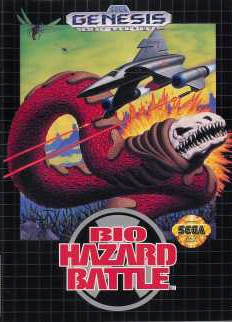
Bio-Hazard Battle, released in Japan as Crying: Aseimei Sensou, is a 1992 scrolling shooter released for the Sega Mega Drive/Genesis and for the Sega Mega Play arcade platform. On February 26, 2007, it was made available on the Wii's Virtual Console. The game was also re-released on the Steam platform on October 26, 2010. An unreleased X68000 version exists currently under ownership of M2 CEO Naoki Horii.

Midnight Resistance is a side-scrolling run and gun game produced by Data East and released in arcades in 1989. Midnight Resistance is set in a dystopian future where the player controls a member of a resistance movement who goes on a mission to rescue his kidnapped family from a drug kingpin.

Sub-Terrania is a 1994 multidirectional shooter developed by Danish studio Zyrinx and published by Sega for the Mega Drive/Genesis. The game takes place in the future, where a deep-space mining colony has been invaded by an unknown alien race. The player assumes the role of a lone pilot who must defeat the alien forces and rescue the trapped miners. During the course of the game, the player controls a rotatable craft with thrusters that is constantly subject to gravity and the craft's inertia. Using the ship's "rotate-and-thrust" capabilities, the players must aim, shoot, dodge and carefully maneuver their way through the hazardous landscape while constantly taking gravity and refueling needs into account.

Taz in Escape from Mars is a video game developed by HeadGames and released by Sega in 1994 for the Genesis/Mega Drive and Game Gear featuring Taz, the Looney Tunes Tasmanian devil cartoon character. The Game Gear version was ported by TecToy to the Master System and released in March 1997 only in Brazil. Taz must escape from Mars, where he was brought by Marvin the Martian. The game includes six worlds with two or three levels in each world.

Home Alone is the title of several tie-in video games based on the film of the same name written by John Hughes. Versions were released for the Nintendo Entertainment System, Game Boy, Super Nintendo Entertainment System, Master System, Sega Genesis, Game Gear, Amiga, and MS-DOS platforms.

Creature Shock is a 1994 sci-fi first-person crawler game released for MS-DOS and 3DO. It was developed by Argonaut Games and published by Virgin Interactive. The game was later ported to the CD-i, Sega Saturn and PlayStation video game systems.

Slap Fight is a 1986 vertically scrolling shooter arcade video game developed by Toaplan and published by Taito. Set on the colonized fictional planet of Theron in the future, where an alien race led by Gaudy have invaded the human-controlled location, players assume the role of an Allied League of Cosmic Nations (ALCON) fighter pilot taking control of the SW475 space fighter craft in a effort to counterattack the invaders. Initially launched for the arcades, the game was later ported to other microcomputer and console platforms by various third-party developers, with each one featuring several changes or additions compared to the original release.

Total Eclipse is a space flight simulation video game developed and published by Crystal Dynamics for 3DO. It was later ported to the PlayStation under the title Total Eclipse Turbo. The game was copyrighted in 1993 and released 1994. Total Eclipse Turbo was a launch title for the PlayStation in the U.S., with the game's released date predating the North American console launch by 11 days. A sequel, Solar Eclipse, was released for Sega Saturn and PlayStation.
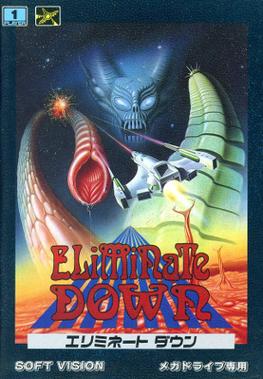
Eliminate Down is a 1993 scrolling shooter video game developed by Aprinet and published by Soft Vision International for the Sega Mega Drive. The game was released in Japan on June 25, 1993 and in South Korea in 1993. Eliminate Down gives players immediate access to three directional-based weapons that could all be powered up as they fought strange alien enemies through eight enormous levels.

Black Hole Assault is a fighting video game developed by Micronet co., Ltd. for the Sega Mega-CD in 1992. The game is the sequel to Micronet's Heavy Nova, though focusing entirely on Fighting Game elements.

Star Strike is a single-player video game, released by Mattel for its Intellivision video game system in 1981. The Intellivision's best-selling game in 1982, with over 800,000 copies sold, Star Strike was inspired by the attack on the Death Star in the 1977 film Star Wars. The player must drop bombs on alien weapons silos before Earth moves into range.

DarkOrbit, later renamed to DarkOrbit: Reloaded is a massively multiplayer online game developed by Bigpoint Games. The game is set in outer space, where players control a spaceship to battle against non-player characters and other players. It is a three-dimensional isometric Flash game with over 300 million registered accounts.

Radix: Beyond the Void is a 2.5D first-person shooter developed by Canadian studio Neural Storm Entertainment and published by Epic MegaGames for MS-DOS in 1995.

Galaga '91 is a 1991 fixed shooter video game developed and published by Namco for the Game Gear. It was published by Sega in Europe and renamed Galaga 2. The first portable installment in the Galaxian series, players control a lone starfighter in its mission to eradicate the hostile Galaga forces before they take over Earth. Gameplay revolves around shooting down formations of enemies and avoiding their projectiles.





















